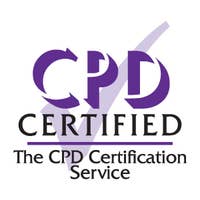PAT Testing Course
Quantity: 1

Duration 1-2 hours




100% online training
Start when you like
Learn on any device (desktop, mobile or tablet)
Instant assessment and result
1 learner per course
Train teams of all sizes
Bulk discounts starting at 10% off 10 courses
Pay by invoice with 30 day payment terms available (5+ courses)
Includes a 10% discount for 10+ courses
Electrical equipment is present in virtually all workplaces, and that includes portable appliances. Managers and responsible persons in low risk environments have a duty to carry out visual and pre-use checks on equipment.
This PAT testing course will familiarise you with the task of portable appliance testing and ways you can help minimise the risk of electrocution, electric shock, and electrically-initiated fires in the workplace. You will learn about the basics of PAT so you're able to offer your support and ensure electrical equipment does not put people's health and safety at risk while at work.
Note that this course provides awareness level knowledge. In low risk environments, such as offices, it provides sufficient knowledge to allow the learner to conduct PAT Tests but, in higher risk areas, a greater level of knowledge is required and this course is not suitable.
100% online training
Access anywhere
Same day digital certificate
Printed certificate posted next working day
Full audio voiceover
Assessment retakes at no extra cost
Developed by health and safety professionals
City & Guilds Assured
Accredited by CPD and assured by RoSPA Qualifications
Bulk discount for orders of 10+ courses

Save on our courses when you buy more training upfront. Lock in a better price now and access the training whenever you need to. You can mix and match any of our courses too and get the discount off your whole order.
10+ courses = 10% off
50+ courses = 20% off
100+ courses = 30% off
500+ courses = 40% off
By the end of this course, you will understand:
If your employees are working from home and use portable electrical equipment (such as laptop computers, display screens and cameras) as an employer, you are responsible for ensuring that their equipment is safe and without risks, including portable electrical equipment.
While there are no UK PAT Testing Regulations, employers have a legal duty to ensure that electrical equipment used for work purposes is safe under the following legislation:
Employers of home workers must maintain any equipment used for work purposes. This may involve arranging for someone to go to their home to check the equipment or having the employee send equipment to a central office for inspection, testing, and maintenance where required.
Employers need to ensure that those who use electrical equipment have received sufficient instruction, information and, where necessary, training to use the equipment safely and so they know to report any issues. This PAT course will be useful training for anyone who may be involved in checking the work equipment of home workers and carrying out PAT tests, based on the employer's risk assessment.

City & Guilds Assured
Thoroughly reviewed independently by City & Guilds learning and development experts, this course is approved as City & Guilds Assured. High Speed Training is the first e-learning provider to have online courses awarded City & Guilds Assured status.

Accredited by CPD
All of our courses are accredited by the CPD Certification Service as conforming to universally accepted Continuing Professional Development (CPD) guidelines.

Assured by RoSPA Qualifications
This course is also assured by the Royal Society for the Prevention of Accidents through their RoSPA Qualifications Assurance System, as providing up-to-date, quality and content-approved training.
Recommended renewal:
3 years
What does this mean? This certificate does not have an expiry date, however, based on industry best practice guidelines there is a recommended renewal period.
Our in-house Learning Designers develop all of our courses to give you and your learners the most engaging training possible.








What is portable electrical equipment, what are the safety risks, legislation and legal duties, and duties on manufacturers, importers or distributors.
What is a risk assessment, who should carry out risk assessments, step 1: identify the hazards, step 2: determine who may be harmed, step 3: evaluate the level of risk, step 4: record your findings, and step 5: review and update.
The hierarchy of control, elimination, substitution, engineering controls, administrative controls, personal protective equipment, instruction, information and training instructing employees in use and storage, cables and connection points, faulty equipment, risks from particular equipment, harsh work environments, hired and loaned equipment, emergency procedures, and fire safety.
Class I and Class II equipment, pre-use checks, visual inspections, combined inspections and tests, inspection and test frequencies, failed inspections and tests, and recording findings.
The online assessment is taken on completion of the training material.
You will be asked 20 multiple choice questions with a pass mark of 90%.
The answers are marked automatically so that you’ll instantly know whether you passed. If you don't pass don't worry! You can take the test as many times as you need with no extra charge.
This course is suitable for anyone with a responsibility for health and safety in low risk workplaces such as offices. It is suitable for all employees at any level of the business, as it introduces the learner to and gives them basic knowledge of portable appliance testing; it does not require any previous training.
This course is not suitable for employees working in environments that are considered higher than low risk. This includes schools, gyms, and any industrial premises.
All portable appliances require a different method of testing. It is within our best interest to provide you with accurate advice and information, but it's the duty of the individual responsible for appliance testing to apply the techniques discussed in this course safely and with full confidence.
No, this course does not give guidance on specific equipment. Where appropriate it may be best to contact your PAT Testing equipment manufacturer if you require advice on certain devices.